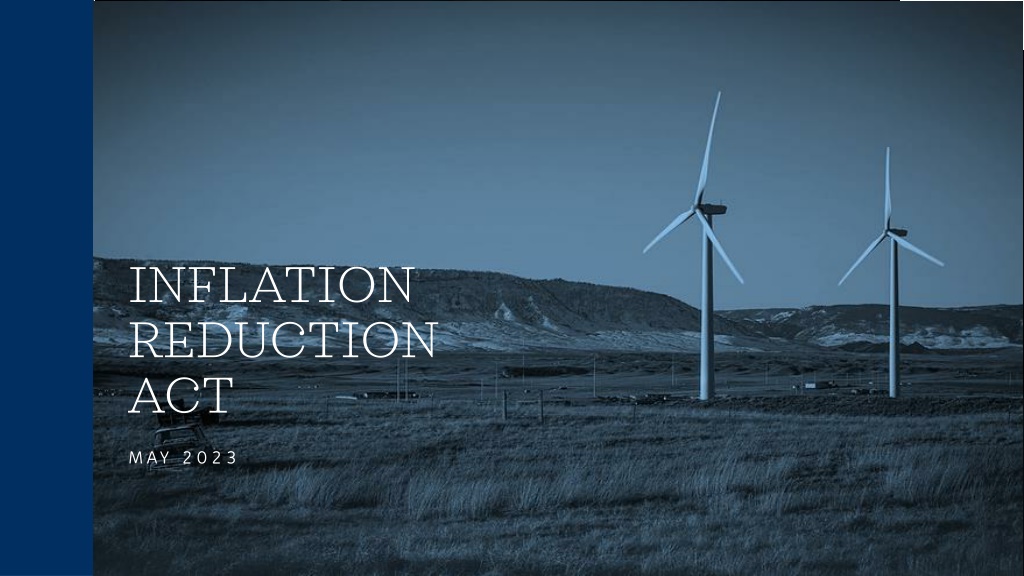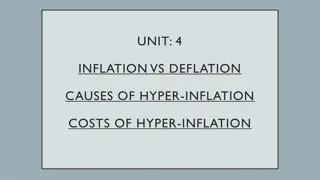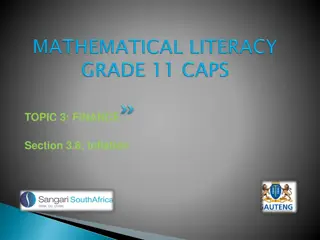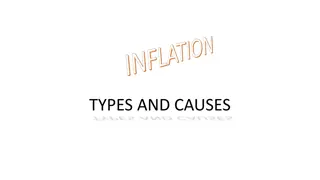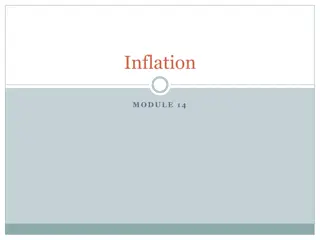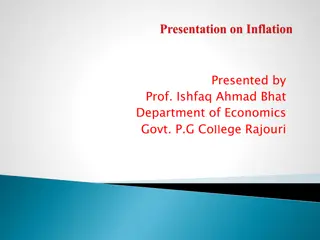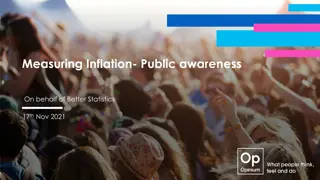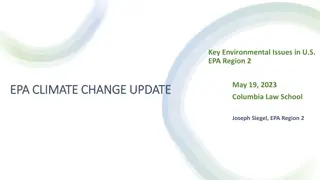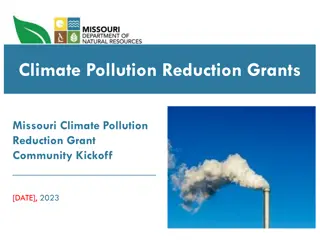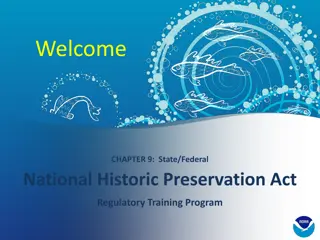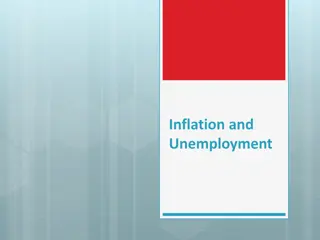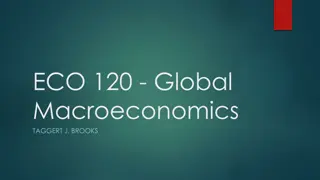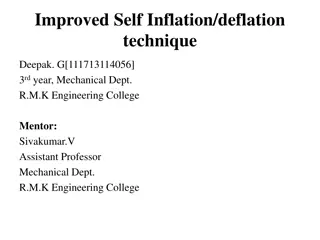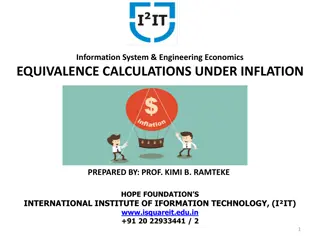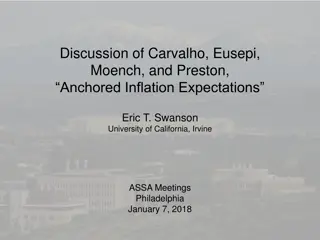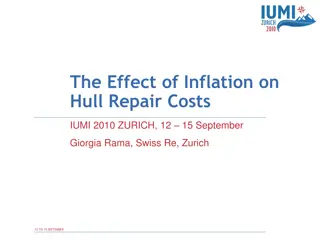Historic Investments in Climate Action: Inflation Reduction Act May 2023
The Inflation Reduction Act (IRA) of May 2023 focuses on making significant investments in climate action to reduce U.S. emissions by an estimated 40% by 2030. This act supports disadvantaged communities, the clean energy industry, and aims to drive emissions reductions over the next decade while paving the way for decarbonization in hard-to-abate sectors. The Environmental Protection Agency (EPA) plays a crucial role in implementing the programs funded by the IRA, receiving substantial appropriations for various initiatives targeting greenhouse gas reduction, climate pollution reduction, environmental and climate justice, air pollution at ports, methane emissions reduction, and clean heavy-duty vehicles.
Download Presentation

Please find below an Image/Link to download the presentation.
The content on the website is provided AS IS for your information and personal use only. It may not be sold, licensed, or shared on other websites without obtaining consent from the author. Download presentation by click this link. If you encounter any issues during the download, it is possible that the publisher has removed the file from their server.
E N D
Presentation Transcript
INFLATION REDUCTION ACT MAY 2023
OVERVIEW The Inflation Reduction Act (IRA) makes historic investments in climate The Inflation Reduction Act (IRA) makes historic investments in climate action action that are expected to reduce U.S. emissions ~40% by 2030 while supporting disadvantaged communities and the clean energy industrial base. IRA investments will drive significant emissions reductions IRA investments will drive significant emissions reductions over the next decade while also laying the groundwork for long-term decarbonization of hard-to-abate sectors. EPA will play a major role in delivering these programs. EPA will play a major role in delivering these programs. The Agency received $41.5 billion in appropriated funds and expects to receive an additional $11.7 billion in future revenue from reinstating the Superfund Tax on oil and gas production. 2
BREAKDOWN OF CLIMATE & ENERGY FUNDING Total Climate and Energy Funding ($, billions) Significant support for the electricity sector (e.g., Production & Investment Tax Credits), manufacturing, energy efficiency, electric vehicles, low carbon fuels.1 Tax Credits 271 Includes $41.5 billion in appropriated spending and $11.7 billion in new Superfund tax revenue. EPA 56 At least 15 other agencies received appropriated funding in the legislation. USDA and DOE were the other two major recipients. U.S. Department of Agriculture 47 Other agencies that received over $1B in appropriations include: Department of the Interior ($6.7B) Department of Transportation ($5.4B) General Services Administrator ($3.4B) Department of Commerce ($3.3B) U.S. Postal Service ($3B) Electric postal trucks! Housing and Urban Development Agency ($1B) Department of Energy 35 Other Agencies 24 1. Preliminary Joint Committee on Taxation analysis. Further CBO projections pending. Source: Senate Democrats, Joint Committee on Taxation, CBO 3
EPA PROGRAMS EPA received $41.5 billion in appropriations to support 24 new and existing programs. This makes EPA the second largest recipient of discretionary funding after the U.S. Department of Agriculture. Six new EPA programs account for 98% of this total funding: Greenhouse Gas Reduction Fund ($27 billion) Provide capital to greenhouse gas mitigation projects not currently able to access private capital, particularly in low-income and disadvantaged communities. Climate Pollution Reduction Grants ($5 billion) Provide grants at the state, local, and Tribal level to develop plans to reduce greenhouse gas emissions and implement those plans. At least one grant will go to an eligible entity in every state. Environmental and Climate Justice Block Grants ($3 billion) Fund community-based nonprofit organizations to support a wide range of climate and environmental justice activities. Reduce Air Pollution at Ports ($3 billion) Award rebates and grants for ports to purchase and install zero-emission technology and develop climate action plans. Methane Emissions Reduction Program ($1.55 billion) Fund grants and technical assistance to accelerate emissions reduction from petroleum and natural gas systems. Also establish a methane waste emissions charge starting at $900 per ton in 2024 and increasing to $1,500 per ton by 2026. Clean Heavy-Duty Vehicles ($1 billion) Provide grants, rebates, and contract support to replace heavy duty vehicles with zero emission alternatives. $400 million is specifically for nonattainment areas. 4
ADDITIONAL PROGRAMS TOTAL $906 MILLION KEY TAKEAWAYS Many of these programs build on existing programs and can proceed quickly through established relationships with state, local, and tribal partners. OCSPP s embodied carbon programs will inform other infrastructure projects such as roads, bridges, and ports. A major investment in permitting will bolster EPA s capacity to provide quality, timely environmental reviews and permitting for critical projects. National Program Office and Program Funding ($) Office of Air (OAR) 491,000,000 Funding to Address Air Pollution - Fenceline Air Monitoring & Screening Air Monitoring 235,500,000 Low Emissions Electricity Program 87,000,000 Diesel Emissions Reductions 60,000,000 Funding to Address Air Pollution at Schools 50,000,000 Funding for Implementation of the American Innovation & Manufacturing Act on HFCs 38,500,000 Funding for Section 211(o) of the Clean Air Act (Renewable Fuels) 15,000,000 Greenhouse Gas Corporate Reporting 5,000,000 Office of Chemical Safety and Pollution Prevention (OCSPP) 350,000,000 Environmental Product Declaration Assistance 250,000,000 Low-Embodied Carbon Labeling for Construction Materials 100,000,000 Permitting (Multiple Offices) 40,000,000 Efficient, Accurate, and Timely Permitting Reviews 40,000,000 Office of Enforcement and Compliance Assurance (OECA) 25,000,000 Funding for Enforcement Technology & Public Information 25,000,000 5
ADDITIONAL INFORMATION IN IMPLEMENTATION FRAMEWORK DOCUMENT ON EPA.GOV/GGRF THE GREENHOUSE GAS REDUCTION FUND (GGRF) HAS THREE PROGRAM OBJECTIVES The three Greenhouse Gas Reduction Fund program objectives Reduce emissions of greenhouse gases and other air pollutants Deliver benefits to American communities especially low- income and disadvantaged communities Mobilize financing and private capital to stimulate additional deployment Tackle the climate crisis and protect public health by supporting the climate goals of the United States to reduce greenhouse gas emissions 50- 52 percent below 2005 levels in 2030 and achieve net-zero emissions by no later than 2050 Maximize the benefits of GGRF investments to Americans; every GGRF competition will align with the President s Justice40 requirements, ensuring that 40% of the overall benefits from a program flow to disadvantaged communities Catalyze market transformation by addressing the barriers to mobilizing private capital into clean projects in undercapitalized markets and facilitating tens of thousands of clean technology projects that deliver tangible benefits to millions of American households 6 https://www.epa.gov/inflation-reduction-act/greenhouse-gas-reduction-fund
ADDITIONAL INFORMATION IN IMPLEMENTATION FRAMEWORK DOCUMENT ON EPA.GOV/GGRF TO ACHIEVE THESE THREE OBJECTIVES, THE GGRF PROGRAM WILL RUN THREE GRANT COMPETITIONS Overview of the Greenhouse Gas Reduction Fund competition structure National Clean Investment Fund Clean Communities Investment Accelerator Solar for All Competition description Fund 2-3 national nonprofits to partner with private capital providers to deliver financing at scale catalyzing tens of thousands of clean technology projects Fund hub nonprofits to rapidly build clean financing capacity of networks of community lenders to finance pollution-reducing projects in low- income & disadvantaged communities Support states, territories, Tribal & municipal governments, & nonprofits to expand access to solar for low- income & disadvantaged communities by priming markets for investment Number and type of grantees 2-3 national nonprofits 2-7 hub nonprofits Up to 60 states, Tribal & municipal governments, & eligible non-profit entities Funding available Nearly $14B $6B $7B Expected impacts Historic public sector investment with the scale to attract private capital leverage in clean projects, supporting the 2030, 2035, & 2050 climate goals of the United States and catalyzing tens of thousands of clean technology projects Robust pipeline of thousands of community-led clean projects with meaningful benefits, generated by hundreds of community lenders capitalized by GGRF to start or expand clean lending in underserved communities Energy bill savings and energy resiliency for millions of underserved American households via states, Tribal & municipal governments, & other recipients creating new or expanding existing low-income solar programs across the country 7
CLIMATE POLLUTION REDUCTION GRANTS $250 million for Climate Pollution Reduction (CPRG) Planning Grants with at least one grant to an eligible entity in every state; noncompetitive. Eligible entities: States, air agencies, municipalities, Tribes, or combinations Arizona has applied; Maricopa Association of Governments (Phoenix) and Pima County DEQ (Tucson) are preparing their applications Plans shall include programs, policies, measures, and projects that will achieve or facilitate the reduction of greenhouse gas air pollution. $4.6 billion for competitive CPRG Implementation Grants. Activities must be covered in a plan developed with funding from a CPRG planning grant. www.epa.gov/inflation-reduction-act/climate-pollution-reduction-grants 8
ENVIRONMENTAL AND CLIMATE JUSTICE BLOCK GRANTS $2.8 billion to provide environmental and climate justice block grants for activities benefiting disadvantaged communities. $200 million for technical assistance. Request for Information closed on April 10, 2023 Seeking Input on: o ECJ Program Design o Types of Projects to Fund o Reducing Application Barriers o Reporting and Oversight o Technical Assistance 9 https://www.epa.gov/inflation-reduction-act/inflation-reduction-act-environmental-and-climate-justice-program
MOBILE SOURCE PROGRAMS OVERVIEW Clean Heavy-Duty Vehicles: $1B for zero-emission vehicles, infrastructure, and workforce development. Ports: $3B for zero-emission port equipment, related planning and permitting, or to develop climate action plans For both of the above programs, Request For Information (RFI) open until June 5, 2023. https://www.epa.gov/inflation-reduction-act/clean-heavy-duty-vehicle-program https://www.epa.gov/inflation-reduction-act/clean-ports-program 10
METHANE EMISSIONS PROGRAM OVERVIEW Petroleum and Natural Gas Systems $850 million for incentives for methane mitigation and monitoring $700 million for incentives for methane mitigation from marginal conventional wells Establishes a waste emission charge ($900 to $1,500 per metric ton depending on the year) for emissions greater than 25,000 metric tons CO2e. Begins in 2024 11 https://www.epa.gov/inflation-reduction-act/methane-emissions-reduction-program
RESOURCES White House Inflation Reduction Act Guidebook: https://www.whitehouse.gov/cleanenergy/inflation-reduction-act-guidebook/ EPA IRA: https://www.epa.gov/inflation-reduction-act https://www.epa.gov/inflation-reduction-act/epa-funding-announcements-bipartisan- infrastructure-law-and-inflation 12
Planning grant allocations States: $156 million Up to $3M per state + DC + Puerto Rico Locals: $67 million Territories: $2 million Tribes: $25 million U.S. Environmental Protection Agency 13
Notice of Intent to Participate (NOIP) Award (estimate) Planning Grant Planning Grant Application Application Process Process Entity Application States March 31, 2023 April 28, 2023 Summer 2023 Fall 2023: Announce notice of funding opportunity for the implementation grants, which will be awarded under a competitive process. Municipalities April 28, 2023 May 31, 2023 Summer 2023 Territories N/A June 15, 2023 Late Summer 2023 Tribes Request informal notice by April 28, 2023 June 15, 2023 Late Summer 2023 Implementation grant applications will be due in first quarter of 2024. 14 U.S. Environmental Protection Agency
